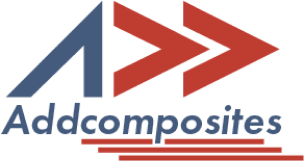





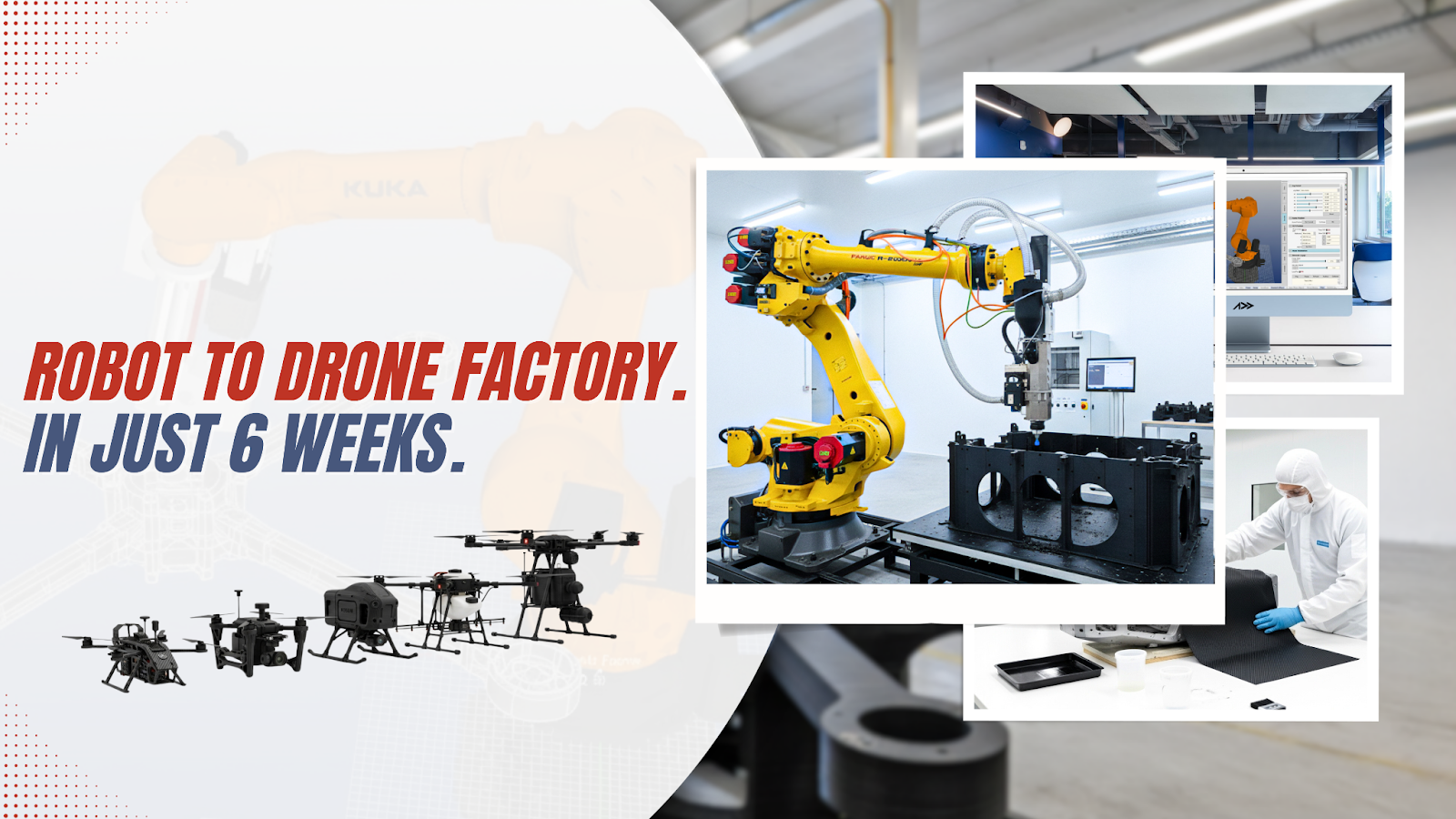
The drone industry is experiencing explosive growth, with market demands shifting from custom-built prototypes to mass-produced fleets for delivery, agriculture, surveillance, and defense applications. Yet manufacturers face a critical bottleneck: traditional production methods can't deliver the combination of lightweight structures, design flexibility, and cost-effectiveness required for commercial viability.

Carbon fiber hand layup produces exceptional strength-to-weight ratios but requires weeks of skilled labor per unit. Injection molding offers speed, but demands €500,000+ tooling investments that lock designs for years. Metal fabrication adds weight that destroys flight efficiency. Small-scale 3D printing lacks the size and speed for production volumes.
At Addcomposites, we've shattered these limitations with our LFAM (Large Format Additive Manufacturing) technology – a revolutionary system that transforms standard industrial robots into high-throughput drone production centers. By processing low-cost polymer granulates at speeds up to 12 kg/hour, LFAM enables manufacturers to produce everything from 250mm racing drones to 3-meter and higher cargo UAVs on the same equipment, with design changes possible in minutes rather than months.
The transformation is immediate: your existing KUKA, ABB, or Fanuc robot becomes a drone factory with material costs reduced by 80% compared to traditional methods.


Traditional filament-based 3D printing has failed to scale for drone production due to prohibitive material costs (€50-200/kg) and limited material options. Our LFAM print head accepts standard polymer granulates – the same raw materials used in injection molding – fundamentally changing the economics of drone manufacturing.
Material Options and Costs:
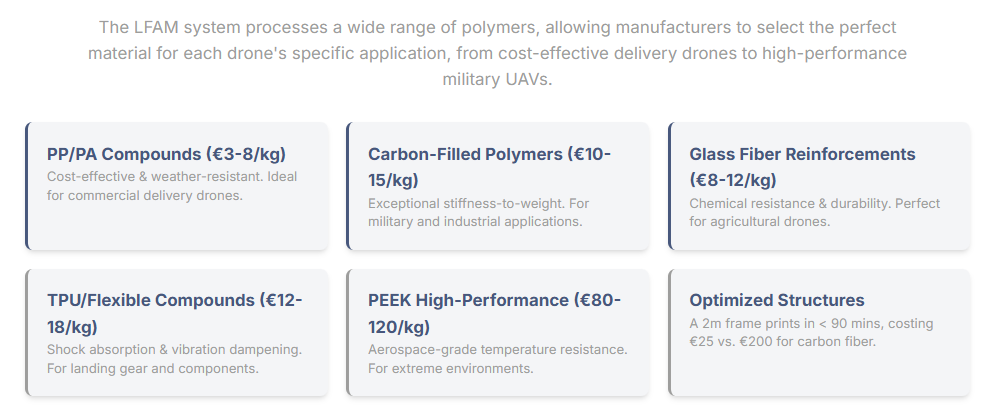
The sophisticated barrel and screw design in our LFAM system processes these granulates into a controlled, pressurized melt stream, creating precise rectangular beads that become the building blocks of optimized drone structures. Deposition rates up to 12 kg/hour mean a complete 2-meter delivery drone frame prints in under 90 minutes.
This isn't incremental improvement – it's transformation. A delivery drone frame that costs €200 in carbon fiber prepreg or €150 in machined aluminum now costs €25 in glass-filled PA, while maintaining comparable mechanical properties through optimized geometry and selective reinforcement.
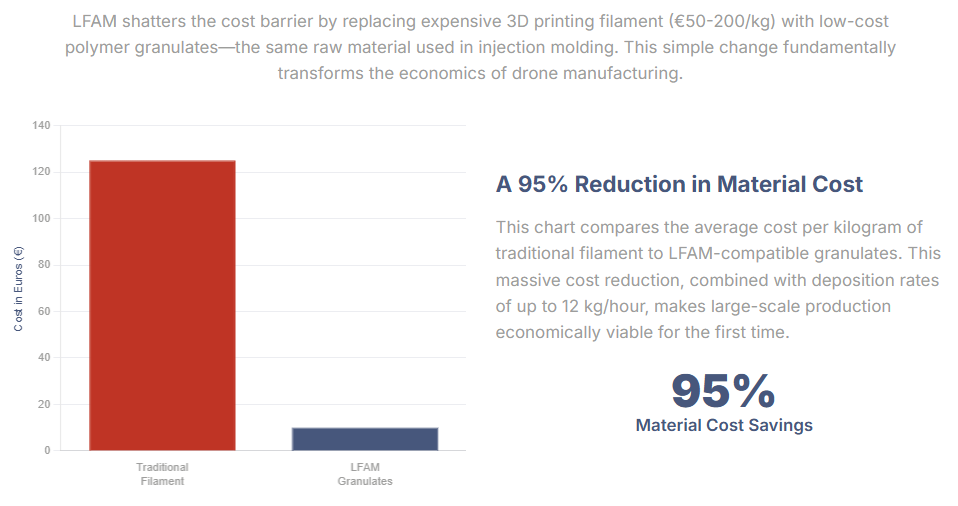
Drone structures demand aerospace-grade precision, repeatability, and quality control. The LFAM system delivers through integration with the complete Addcomposites ecosystem, providing capabilities specifically optimized for UAV manufacturing.
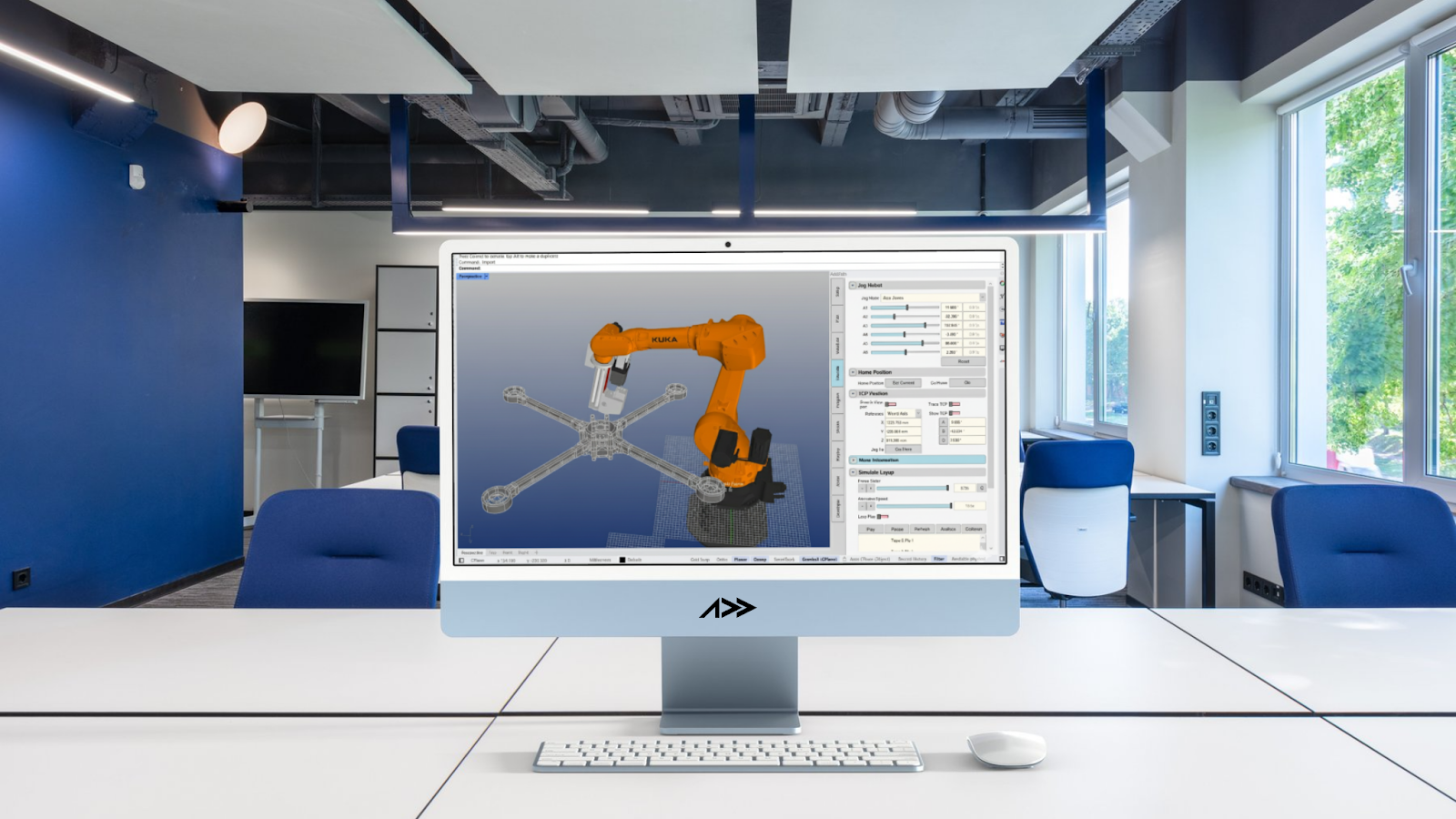
AddPath Intelligence for Drone Optimization: Our proprietary path planning software generates specialized toolpaths for drone structures including variable density patterns that maximize strength while minimizing weight, aerodynamic surface finishing with controlled bead placement, automated internal lattice structures for weight savings, integrated wire routing channels for clean cable management, and localized reinforcement at motor mounts and stress points. The system simulates complete print sequences before production, showing exact weight distribution and center of gravity calculations critical for flight performance.
Digital Twin Quality Assurance: Every sensor feeds real-time data to our digital twin platform, enabling weight monitoring to ensure each component meets flight specifications, dimensional accuracy verification for proper assembly fitment, void detection through temperature and flow analysis, complete batch traceability for aerospace compliance, and predictive maintenance to prevent defects. This manufacturing intelligence ensures every structure meets exacting standards while building a database for continuous optimization.
Seamless Composite Integration: Using the same robot and AddPath software, manufacturers can print base structures with LFAM then add strategic continuous fiber reinforcement using our AFP-X or SCF3D heads. This hybrid approach delivers 70% weight reduction compared to aluminum, 300% strength increase over unreinforced plastics, and optimized stiffness for vibration reduction – all in a single automated work cell.
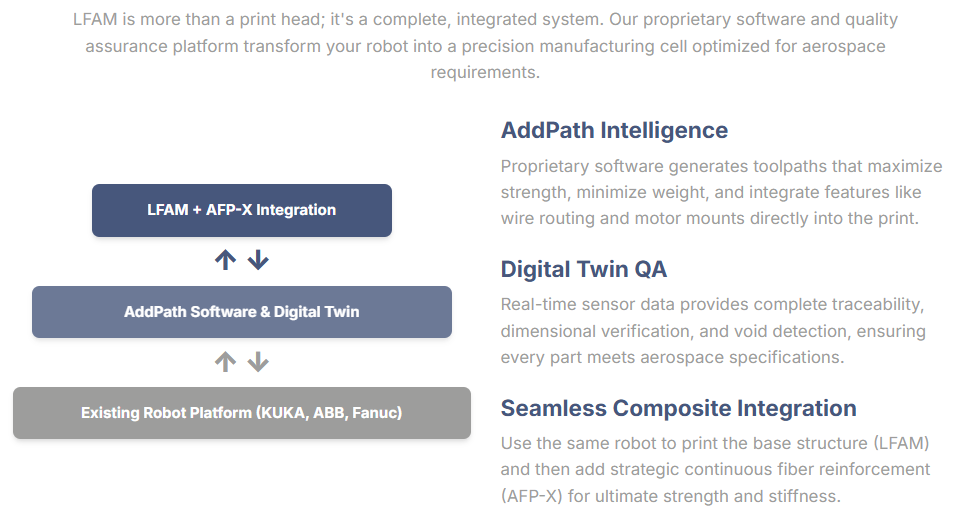
The LFAM system adapts to every market segment, each with unique requirements and production economics. The same equipment that produces racing drone frames in the morning can manufacture agricultural UAV structures in the afternoon.
Racing & Consumer Drones (250-500mm): Production rates exceed 50 frames daily with material costs of just €2-5 per frame. The key advantage is rapid design iteration – test new aerodynamic concepts weekly instead of waiting months for tooling. Integrated features include camera mounts, antenna housings, and customizable motor configurations printed directly into the structure.
Commercial Delivery Drones (1-2m wingspan): Systems produce 10-15 complete structures daily at €20-50 material cost per unit. Customizable payload bays accommodate different package sizes while integrated battery compartments optimize weight distribution. Weather-sealed construction and modular maintenance panels reduce operational costs while maintaining a 5kg payload capacity with 45-minute flight times.
Agricultural Drones (2-3m wingspan): Production rates of 5-8 units daily meet seasonal demand spikes with €50-100 per frame in chemical-resistant materials. Integrated tank structures eliminate assembly steps while reinforced landing gear handles rough field conditions. Spray system integration and GPS mount points come standard, with customizable tank capacities from 10-30 liters based on application requirements.
Industrial Inspection & Military UAVs: Specialized units feature sensor mounting customization for any payload configuration, EMI shielding integration for sensitive electronics, and vibration isolation for camera stability. Military applications leverage PEEK and carbon-filled polymers for extreme environments, with on-site production capability ensuring design security. Rapid prototyping enables iteration from concept to flight testing in days rather than months.


The financial impact of LFAM drone manufacturing extends beyond material savings to fundamentally transform business models and market opportunities.
Case Study: Logistics Company Fleet Production A major logistics provider needed 500 delivery drones monthly for urban operations. Traditional carbon fiber manufacturing quoted €800 per frame with 12-week lead times. With LFAM implementation on two existing robots, they achieved 25 units/day production capacity, €65 material cost per frame, 3-day order-to-shipment cycles, and system payback in just 6 weeks. Annual savings exceeded €4.4 million while enabling regional customization for different markets.
Case Study: Agricultural Drone Manufacturer An agritech company struggled with seasonal demand fluctuations and regional variants. LFAM enabled production of 8 different configurations without tooling changes, 85% inventory reduction through on-demand manufacturing, 30-minute changeover between variants, and response to sudden orders within 48 hours. The flexibility to produce exact quantities needed reduced working capital requirements by €2 million.
Comprehensive ROI Analysis (1000 units/year):
Traditional manufacturing demands massive upfront investment and operational costs, often requiring €500,000 in tooling investment before producing a single drone, with each unit costing €200 in materials plus €150 in labor. Lead times stretch 8-12 weeks, and any design change means another €100,000+ investment in new tooling. With a total unit cost of €850, you need to sell 2,000 units just to break even.
LFAM production transforms these economics completely. Using your existing robot with our LFAM system, material costs drop to €40 per unit with just €20 in labor thanks to high automation. Lead times shrink to 1-2 weeks, and design changes cost nothing – just update the software and keep printing. At €210 total unit cost, you break even after just 200 units, entering profitability 10x faster than traditional methods.
Result: 75% cost reduction, 90% lower investment, 10x faster design iteration
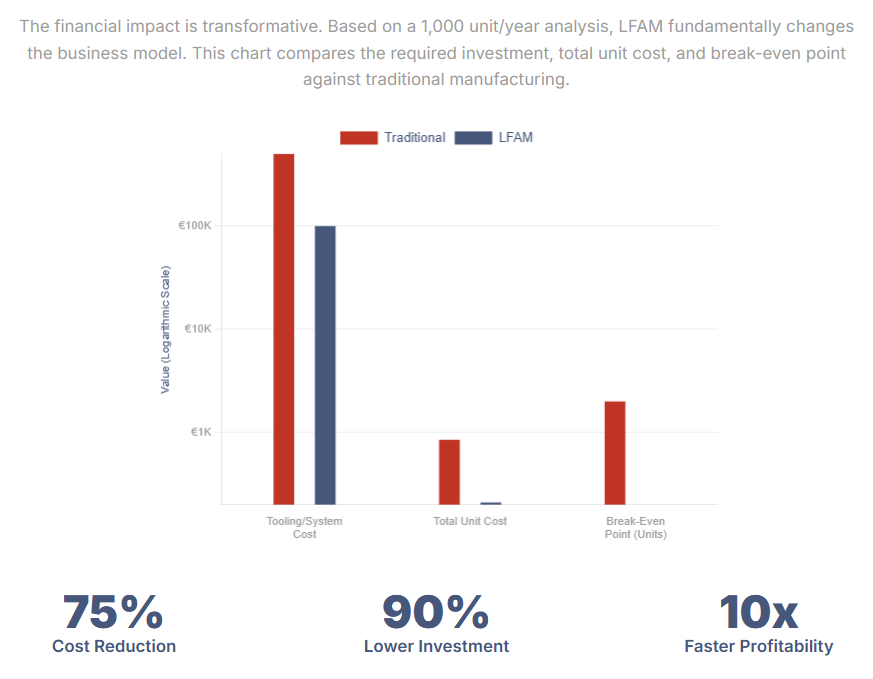
The drone market is exploding. Manufacturers using LFAM technology will dominate. Your existing robots can become drone production systems today – every idle robot cell is a missed opportunity.

Why Choose Addcomposites LFAM: Our proven technology powers over 40 systems worldwide, producing everything from aerospace components to marine structures. The complete Addcomposites ecosystem integrates LFAM with AFP-X continuous fiber reinforcement and SCF3D printing, all controlled through unified AddPath software. Most customers achieve full payback in less than 2 years, supported throughout by our drone manufacturing specialists who ensure your success from installation through production scaling.
Your 6-Week Fast Track: Implementation follows a proven pathway that gets you producing drones in just six weeks. During weeks 1-2, we provide free evaluation of your existing robots and detailed simulation of your specific drone designs. Weeks 3-4 bring live demonstrations where you'll see your actual components being printed and validated. By weeks 5-6, we're installing the system on your robot, training your team, and supporting your first production runs.
Take Action Now:
📧 Email: info@addcomposites.com
📞 Call: +358 (0)503 305 201
🌐 Book Demo: Request Demo
💼 LinkedIn: Connect with our specialists
🚁 Start Your Revolution Today → www.addcomposites.com
Transform your robots. Dominate your market. The future of drone manufacturing is here.
